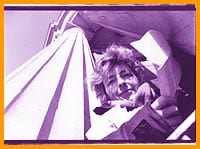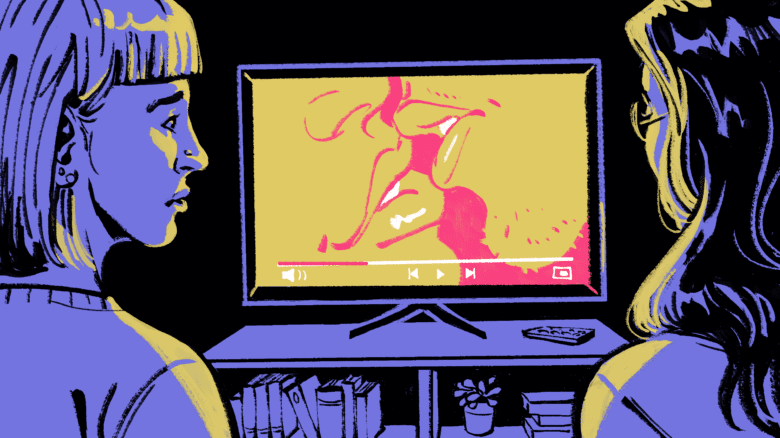There are happy endings. Childhood friends Dr Frieda Fraser and Dr Edith Bickerton Williams fell in love while in a sorority at the University Of Toronto in 1918 – and their affair lasted most of the century.
The pair recorded their relationship through a detailed correspondence that began in 1925 when Edith’s parents sent her to England to keep her away from Frieda in Toronto.
“My best beloved,” wrote Edith a year later, “I love you without any reservations and more than I would have believed possible to do – I adore you – and it must be for always because I don’t see how there could be any me without it.”
The upper-middle class parents of both Edith and Frieda vehemently opposed the scandalous relationship.
Familial pressure did not succeed in breaking them up, but it did prevent the pair from setting up a residence together until 1939, when Frieda’s mother died.
“They struggled to get together in the beginning of their relationship,” says historian Kato Perdue. “There was so much pressure pulling them apart, but they just knew that they were meant to be together and they held on with amazing tenacity. In the end, they got their happy ending. They had a long, happy life together.”
When Frieda, a medical doctor and microbiologist, passed away in 1992 (at the age of 94) her family found thousands of letters chronicling the lesbian love affair amongst her lecture and research notes. In all the letters, Edith (who was always a tomboy), is affectionately referred to as “Bud.”
Instead of burying this testament in the closet, as many relatives do, the family donated the entire collection to the University Of Toronto’s archives.
Perdue, a history graduate student and lecturer at York University, has spent the past three years deciphering and analyzing the enormous love letter collection. She argues that because of the long years of separation, the two women learned how to develop their relationship through writing.
“From 1925 until 1939, while they were separated, they would write daily,” says Perdue. “Sometimes two or three times in a day. Frieda would have letters shoved into her lab coat pockets and be writing more on lunch breaks. Edith kept letters stuffed down the front of her dress while working.”
In addition to letter writing, the two constantly schemed to find ways to see each other. In 1927 Edith came from England for a month visit, explicitly to see Frieda, but her family managed to keep her away for all but three days.
Rendez-vous were hard to plan because of professional, as well as family, demands. Both women were outstandingly successful in their careers and worked constantly. Frieda rose to the top of the medical profession in the early 20th century despite her gender. Edith became a veterinary doctor in the ’30s – one of only five female vets in Ontario at the time.
Their high level of education made them very conscious of the dominant attitudes towards homosexuality in their era.
“Because of working in a medical world, Frieda was very aware of Freud’s theories,” says Perdue. “The two went to lectures and read books discussing the issue… but they didn’t put much stock in what they heard.”
Sigmund Freud, the father of psychoanalysis, was very much in vogue among the intelligentsia of the 1920s. He argued that female homosexuality was a pathological symptom of arrested sexual development.
Instead, in the beginning of their partnership, the women were more influenced by other lesbians in their milieu – whom they referred to as “women totally devoted to women.”
In 1925, when Edith was first sent away to England, she wrote from aboard her ship about an older lesbian couple she had met: “They seem to agree with all we think about it [women being together], and also that there is no use trying to convince any other people about it – they simply can’t see it.”
Frieda replies: “Please tell me more. It is a most extraordinary arrangement this system of partner ship. I suppose it shows the adaptability of the human organism. I didn’t realize till lately how much I need you.”
According to Perdue, Edith and Frieda’s financial security and education allowed them the freedom and independence. However, their upper-middle class status was a double-edged sword.
“Because of their status they also felt that they had to maintain an image of propriety…. It was what prevented them from setting up a life together for almost 20 years. Frieda didn’t feel like she could be seen just up and leaving her mother.
“The threat of being disowned was always there…. It happened to Edith’s best friend [who was also a wealthy lesbian] in the ’20s.”
When they finally did move in together, they were both over 40 years old. They fulfilled their childhood fantasy of a country house and chose to live in Burlington, and commuted to Toronto for work.
Although they would still have another 40 years of marital bliss, not all their girlhood dreams were satisfied. They had planned to adopt children, even have a large family together, but never did.
“I’d like to adopt some kids if we can see our way to it later on,” wrote Frieda in 1926. “As many as we can afford I think – Put not all your eggs in one basket.”
In the 1920s Frieda was working in a women’s and children’s hospital and had access to many unwanted babies. “Because of the male population killed in the war there were lots of single mothers eager to give up their babies,” says Perdue.
“I think in general there was less scrutiny, it was easier for women to adopt babies in the teens and twenties than it would become later on [when Edith and Frieda finally had a home together].”
Perdue says that it is also possible that by the time Edith and Frieda set up a household together they simply felt it was too late to adopt.
They did have a large circle of friends and community members who accepted them as a family. “When Edith died there were condolence letters to Frieda from the whole community [in Burlington] and their United Church.”
Most of the letters in the collection come from Edith and Frieda’s frustrating period of living apart, but they continued to sporadically write love notes and letters to each other until Edith’s death.
That was in 1979, when she was 81 (both women were born in 1898). Frieda lived another 13 years.
“They were very much aware that their letters could one day be published,” says Perdue. “They wanted others to read their correspondence, especially other women like them.”
Both seemed to know that they were documenting a love affair that would last a lifetime.
In a letter to Frieda from aboard ship in 1925 Edith writes this poem: “Something must have happened; Time stood still, Here is our moment, glowing and alive/ It looks so sturdy I’m afraid it will live to be 70 or 75/ It can’t be love. Love comes and goes so fast. What do they call it when it seems to last?”

 Why you can trust Xtra
Why you can trust Xtra


